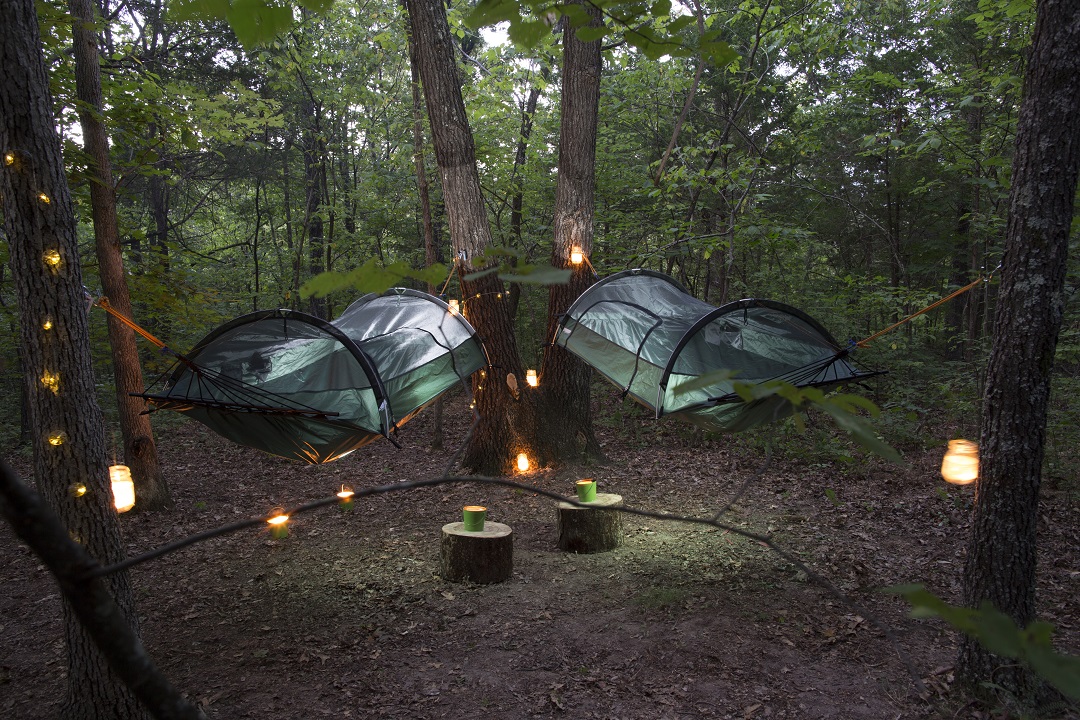I was all set for my first hammock camping experience, or so I thought. The forecast called for clear skies and lows in the 40s. My hammock was hung, I had a 20-degree sleeping bag, multiple layers of clothing, and a fire roaring. There were a million stars overhead.
Fast forward to 3 a.m. I woke up, shivering uncontrollably, causing me to make a quick dash to the heat of my car on the brink of hypothermia. I’d learned my first lesson in hammock camping the hard way — always use an underquilt.
What exactly is an underquilt? We’ll get to that.
Hammock camping is on the rise around the country, but for the novice, the idea of thinking outside the tent can trigger with a lot of questions: What makes hammock camping so appealing? Who is it best suited for? What are the essential gear pieces involved? How do you actually do it?
To get the answers to these and other questions, I spoke with Keith Carr, who along with he his wife operates Famous Home of Hammping, a hammock camping AirBnB near Park Hills, Missouri.
So, first things first, what are the main differences between hammock camping and traditional tent camping?
“Camping in a hammock means you’re not stuck sleeping on the ground,” said Carr, adding that you don’t need a flat campsite, just two trees spaced a usable distance apart. “If it rains, the hammock keeps you out of run-off areas and avoids flooding.”
Hammocks also tend to sway a bit. “It’s a completely different experience than sleeping on solid ground,” Carr added. “Much of our clientele say they’re interested in trying something different.”
Hammock camping setups can be much lighter than tents, with less to pack and carry, which makes it an appealing alternative for backpackers and thru-hikers.
Of course, there are trade-offs, such as the inability to camp above the tree line or in areas where sturdy supports aren’t present. Hammock camping is typically more exposed than tent camping; there’s less storage space; and you won’t be sleeping perfectly flat.
It’s also typically a solo endeavor. “Two people sleeping in a hammock just doesn’t work,” said Carr. “It’s unsteady. Every move causes the hammock to sway. One person, one hammock.” Sorry, snugglebugs.
The recommended gear for hammock camping boils down to five pieces:
Hammock. Hammocks come in all shapes, sizes, and materials. Visit your local outdoor retailer and find one that fits your functionality and budget.
Suspension System. Also known as the straps used to hang the hammock. Most hammock camping brands offer purpose-made systems. Be sure to use straps at least 3/4-inch-wide to protect tree bark.
Underquilt/Sleeping Pad. A sleeping bag loses its ability to insulate when compressed. Underquilts are designed to hang underneath the hammock, avoiding compression and insulating the hammock from the cold air below. Alternatively, a good sleeping pad with a high “R-value” (a measurement of how well the pad reflects heat) will help with insulation.
Rain Fly. Many hammock systems are sold with rain flys. Make sure yours covers your whole hammock. Suspend the rain fly overhead from the support trees or from a ridgeline — a utility cord strung a few feet above your hammock.
Insect Netting. Some nets encapsulate the entirety of the hammock, while others connect to the sides. For additional protection, treat your hammock, rain fly, underquilt, and insect netting with permethrin.

Hammock camping is more exposed than tent camping.
Where to Go Hammock Camping
Klondike Park (Augusta, Mo.) Tree-supported hammock camping is not allowed, but several “Walk-In” campsites are equipped with hammock support posts.
Dr. Edmund A. Babler State Memorial Park (Wildwood, Mo.) Has “Basic” campsites conducive to hammock camping (sites 58-75).
Meramec State Park (Sullivan, Mo.) Allows hammocks at established campsites; must use 1-inch-wide straps and secure to trees only (i.e. not lamp posts).
Cuivre River State Park (Troy, Mo.) Allows hammock camping at established campsites; requires a 2-inch webbed strap to prevent damage to tree bark.
Washington State Park (De Soto, Mo.) Hang your hammock in designated campsites; must use tree-friendly straps (1-inch or more).
Hammock Camping Tips
- Borrow a hammock and try sleeping in it overnight before you go out and buy your own.
- When organizing your hammock camping kit, make sure all the components are compatible.
- Before your trip, check with local land management to ensure hammock camping is allowed in the area.
- Get to the campsite early enough to set up. Finding good supports can be challenging in the dark.
- Use an established campsite when possible, so no vegetation gets trampled, and be sure to check support trees for wildlife.
- Find trees at least 6 inches in diameter. When hanging your hammock, space it evenly between the supports.
- Keep the hammock level, with 30-degree angles from the straps to the supports for good tension.
- Hang the hammock so that the lowest point is no more than 18 inches off the ground.
- When sleeping, lay at an angle across the hammock; this will help avoid the “cocoon effect”.
Author: Nick Tilley is a regular contributor to Terrain Magazine.
Top image: On location at Famous Home of Hammping in Park Hills, Mo.


Only hang with webbing straps, don’t use rope as it can damage the bark and endanger the trees.
ALSO CHECK – poison oak/Ivey, and dead limbs overhead (widow makers).